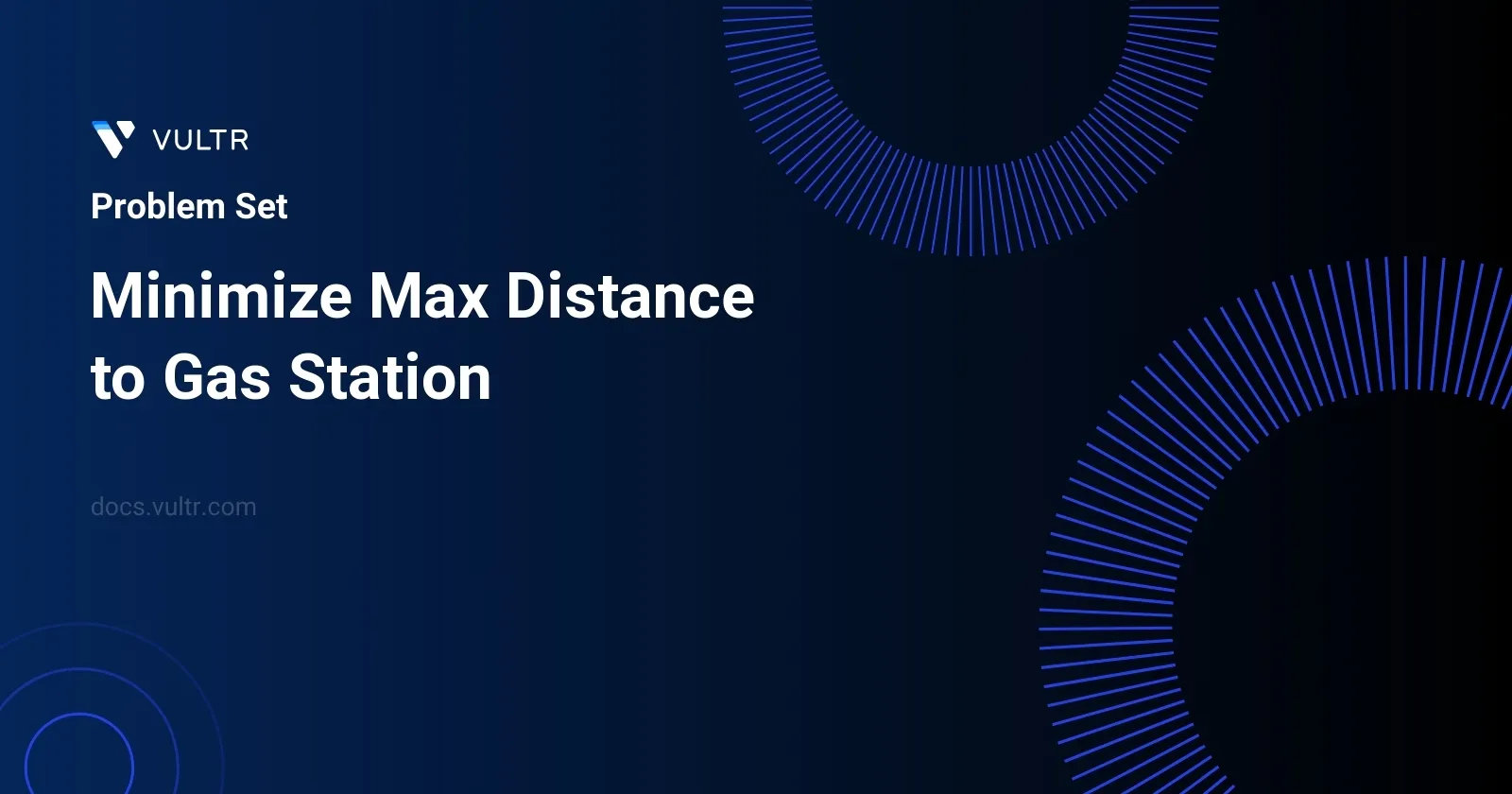
Problem Statement
In this problem, you are given an integer array named stations which represents the locations of gas stations on a straight line (denoted as the x-axis). Additionally, you are provided with an integer k, indicating the number of new gas stations you are permitted to introduce along this line. The placement of new gas stations is not confined to integer coordinates; they can be situated at any point on the x-axis.
The goal is to strategically add these k gas stations to minimize the maximum distance between any two consecutive gas stations—this maximum distance after placement is termed as the penalty(). The solution requires determining the smallest possible value of this penalty() after all new stations are added, adhering to a precision within 10^-6 of the exact answer.
Examples
Example 1
Input:
stations = [1,2,3,4,5,6,7,8,9,10], k = 9
Output:
0.50000
Example 2
Input:
stations = [23,24,36,39,46,56,57,65,84,98], k = 1
Output:
14.00000
Constraints
10 <= stations.length <= 20000 <= stations[i] <= 108stationsis sorted in a strictly increasing order.1 <= k <= 106
Approach and Intuition
Understanding the distance between stations: The initial step involves identifying gaps between consecutive stations as defined by the
stationsarray. These gaps are potential candidates for minimizing through the strategic placement of new stations.Binary Search for Optimal Penalty:
- The approach encompasses a binary search on the potential values of
penalty(). The lower bound (low) of the search can start from0(theoretically placing stations extremely close), and the upper bound (high) can be initialized to the distance between the first and the last station in the list. - For each midpoint (
mid) in this binary search, which represents a candidate for the smallest maximum distance (penalty), attempt to simulate the placement of new stations. For each gap:- Calculate the number of new stations required to ensure that no subsegment within the gap exceeds the distance
mid. - If the total number of new stations required across all gaps exceeds
k, it indicates thatmidis too small, and thus, we adjust our search range accordingly.
- Calculate the number of new stations required to ensure that no subsegment within the gap exceeds the distance
- The approach encompasses a binary search on the potential values of
Iterating to Find Minimization:
- Through the course of the binary search, if a penalty value (midpoint) necessitates fewer or exactly
knew stations to achieve the proposed subsegment distances, it is tagged as feasible. - Adjust the binary range to zero in on potentially smaller feasible penalties, continuing until the range converges sufficiently close to the minimum penalty, achieving the desired precision.
- Through the course of the binary search, if a penalty value (midpoint) necessitates fewer or exactly
Example Analysis:
- For example 1, the equidistant initial setup allows for half-unit placements of 9 new stations to tightly pack and minimize the maximum distance, reflecting in the optimal
penalty(). - Example 2 offers fewer new stations relative to gaps, exemplifying how a solitary new station influences the longest gap, which determines the
penalty()in scenarios of limited placements.
This binary search within specified precision limits provides an efficient pathway to approach and solve the problem, adequately handling the constraints and conditions laid out.
Solutions
- Java
class Solution {
public double findMinDist(int[] position, int Mk) {
double min = 0, max = 1e8;
while (max - min > 1e-6) {
double mid = (min + max) / 2.0;
if (canDistribute(mid, position, Mk))
max = mid;
else
min = mid;
}
return min;
}
public boolean canDistribute(double dist, int[] position, int Mk) {
int count = 0;
for (int i = 0; i < position.length - 1; ++i)
count += (int) ((position[i+1] - position[i]) / dist);
return count <= Mk;
}
}
The Java code provided aims to solve the "Minimize Max Distance to Gas Station" problem by determining the smallest possible maximum distance between gas stations that can be added on a linear route. The method findMinDist implements a binary search to determine this minimum distance. The process adheres to the following steps:
Define initial conditions with the minimum possible distance (
min) set to 0 and the maximum (max) set to 1e8.Use a while loop to continue the search as long as the difference between
maxandminis greater than 1e-6, ensuring precision.Calculate the midpoint (
mid) ofminandmax.The helper function
canDistributechecks if it is possible to distribute gas stations such that the maximum distance between any two stations does not exceedmid. This is achieved by iterating over the positions and comparing the segment distances with the currentmid.If it is possible to distribute within the current
mid, adjust themaxtomid, narrowing the search range for possible maximum distances.If not, adjust
mintomid, focusing on longer possible distances.The procedure continues until the precision condition fails;
mindelivers the smallest feasible maximum distance.
This solution utilizes a binary search mechanism paired with a linear distribution check (canDistribute), combining efficiency in narrowing down possible distances with a valid check for those distances. This results in an efficiently found solution meeting the precision demands of the problem.